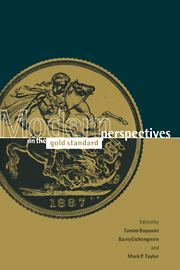Book contents
- Frontmatter
- Contents
- List of figures
- List of tables
- Notes on the contributors
- I Introduction
- II Operation of the gold standard
- 3 The gold standard as a commitment mechanism
- 4 Market efficiency and regime efficiency under the 1925–1931 dollar/sterling gold standard
- 5 Credibility and fundamentals: were the Classical and interwar gold standards well-behaved target zones?
- III Adjustment mechanisms
- IV Monetary issues
- V Exchange rate behavior
- VI Conclusions
- Index
4 - Market efficiency and regime efficiency under the 1925–1931 dollar/sterling gold standard
Published online by Cambridge University Press: 05 November 2011
- Frontmatter
- Contents
- List of figures
- List of tables
- Notes on the contributors
- I Introduction
- II Operation of the gold standard
- 3 The gold standard as a commitment mechanism
- 4 Market efficiency and regime efficiency under the 1925–1931 dollar/sterling gold standard
- 5 Credibility and fundamentals: were the Classical and interwar gold standards well-behaved target zones?
- III Adjustment mechanisms
- IV Monetary issues
- V Exchange rate behavior
- VI Conclusions
- Index
Summary
The gold standard is typically analyzed as a fixed exchange rate regime. While the existence of a gold-point spread is recognized (if only implicitly), the location of the exchange rate is deemed irrelevant as long as the rate remains within the spread. The common procedure, then, is simply to represent the exchange rate by the mint parity, a practice justified by long-term automatic adjustment processes that eliminate balance of payments disequilibria that can exist only at (or beyond) a gold point. In particular, the interwar dollar/sterling gold standard is universally viewed as involving a pound substantially overvalued at the mint parity but with corrective processes stymied by altered circumstances and policies compared to the prewar period, eventually leading to the demise of the gold standard. So the existing studies of the stability of the interwar gold standard are long-term in nature, making no reference to the gold-point spread or the movement of the exchange rate within it.
In this chapter a different focus is adopted. The functioning of a gold standard in general – with the dollar/sterling interwar experience as the case study – is analyzed from the standpoint of short-run efficiency in which the precise location of the exchange rate plays the central role. Two concepts of “efficiency” are utilized: market efficiency, involving the behavior of private parties in response to the profit opportunities afforded by the gold standard, and regime efficiency, pertaining to the probability of maintenance of the gold standard with the existing mint parity.
- Type
- Chapter
- Information
- Modern Perspectives on the Gold Standard , pp. 101 - 128Publisher: Cambridge University PressPrint publication year: 1997



